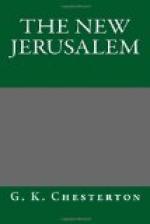In the last chapter I have attempted to suggest a background of the battlemented walls with the low gates and narrow windows which seem to relieve the liveliest of the coloured groups against the neutral tints of the North, and how this was intensified when the neutral tints were touched with the positive hue of snow. In the same merely impressionist spirit I would here attempt to sketch some of the externals of the actors in such a scene, though it is hard to do justice to such a picture even in the superficial matter of the picturesque. Indeed it is hard to be sufficiently superficial; for in the East nearly every external is a symbol. The greater part of it is the gorgeous rag-heap of Arabian humanity, and even about that one could lecture on almost every coloured rag. We hear much of the gaudy colours of the East; but the most striking thing about them is that they are delicate colours. It is rare to see a red that is merely like a pillar-box, or a blue that is Reckitt’s blue; the red is sure to have the enrichment of tawny wine or blood oranges, and the blue of peacocks or the sea. In short these people are artistic in the sense that used to be called aesthetic; and it is a nameless instinct that preserves these nameless tints. Like all such instincts, it can be blunted by a bullying rationalism; like all such children, these people do not know why they prefer the better, and can therefore be persuaded by sophists that they prefer the worst. But there are other elements emerging from the coloured crowd, which are more significant, and therefore more stubborn. A stranger entirely ignorant of that world would feel something like a chill to the blood when he first saw the black figures of the veiled Moslem women, sinister figures without faces. It is as if in




